For years, I’ve held a profound appreciation for the wines of Alentejo whose wines have consistently captivated my palate. Last month, I had the opportunity to transform my virtual explorations of Alentejo wine into reality during a week long press trip. It was immersive experience that included captivating winery visits and tastings, indulgence in the delectable Alentejano cuisine, a cultural tour that unfolded the region’s heritage, and an enlightening educational seminar.
About Alentejo
Alentejo (ah-len-TAY-zhoo) is situated in the southern half of Portugal, bordered by the Tejo River to the north, the Algarve to the south, Spain to the east, and the Atlantic Ocean to the west. Emcompasing a third of the country, it is the largest region in Portugal. It is approximately the size of the state of Massachusetts,
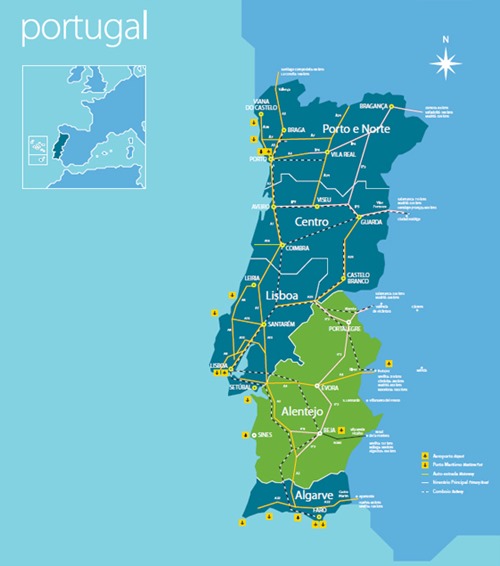
Winemaking in the Alentejo dates back 4,000 years, but it wasn’t until the 1980s when investment from the European Union enabled a number of cooperatives to focus on elevating the quality of its wines. Over the last 25 years the region has seen an over 400% growth in the number of producers. Most of the wineries are family owned and operated. The region has dominated the domestic market share since 2010. While its easy drinking, rich and fruity wines are the darlings of Lisbon cafés and restaurants, the region also features more complex fine wines, both red and white.
In fact, Alentejo wine is the preferred wine for Portuguese consumers, a a population that boasts the highest per capita wine consumption globally! It is consumed as much as all the other Portuguese wine regions put together.
The region’s terroir includes an undulating topography, and its climate features cold winters and hot, dry summers that make irrigation necessary. There is a mix of heterogeneous soil types including schist, pink marble, granite, limestone, often laid upon a sub-layer of water-retaining clay.
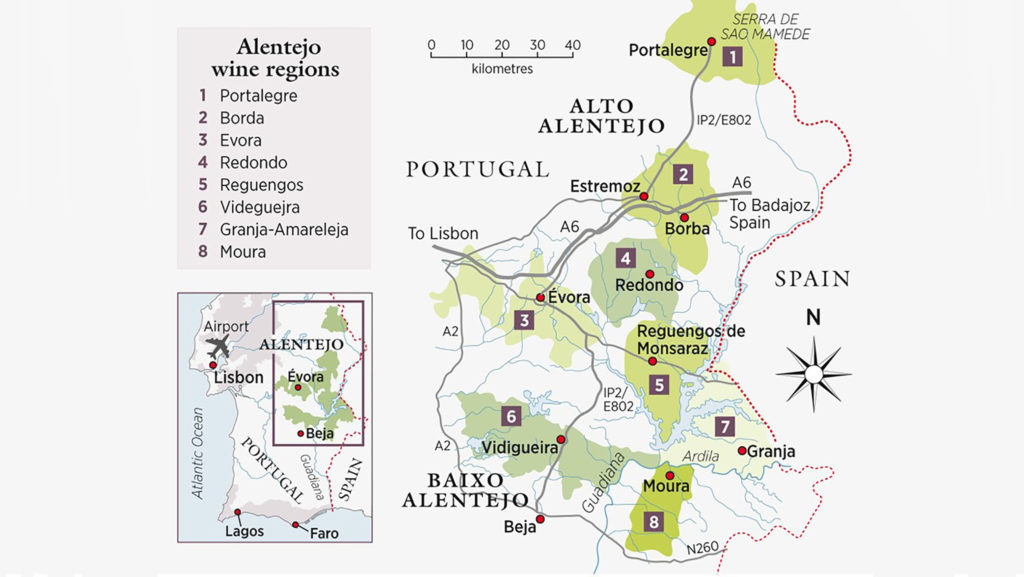
Alentejo has its own DOP (appellation) title, as well as a wider Vinho Regional Alentejano designation. The DOP has eight subregions (see map above), which span from the mountains to the hot, dry center of the region: Portalegre, Borba, Évora, Redondo, Reguengos, Granja-Amareleja, Vidigueira and Moura.
A fair question about Alentejo is “Why isn’t it as well known as other Portuguese wine regions such as Port, the Douro, or Vinho Verde?” The answer traces back to historical disruptions in viticulture. During the dictatorship of Antonio de Oliveira Salazar (1932-1968), Alentejo’s landscape was transformed into the country’s breadbasket as vineyards were uprooted in favor of wheat. Post-Salazar, the Carnation Revolution in 1974 ushered in a new government with a communist-leaning faction, leading to the turnover of expansive wine estates to workers and the nationalization of banks, further adversely impacting Alentejo’s wine industry.
Top 10 Reasons Alentejo Is A Wine Lover’s Paradise
Our first full day in Alentejo kicked off with a joyous gathering at Adega Natus Vini, celebrating Dia de Sao Martinho (Saint Martin’s Day). Eager to delve into the world of Adega Natus Vini, armed with a notebook for detailed notes about the winery and the wines, I soon realized that owner and winemaker Hamilton Reis prioritized the communal celebration over an in-depth discussion of his wines. As friends continued to pour in with their own wines and delectable dishes, the essence of community and the significance of Saint Martin’s Day took center stage. I decided to stow away my notebook, immersing myself in the spirit of the occasion.
That first experience has inspired me to pull back the lens on the Alentejo, and share the broader and more profound aspects of the Alentejo experience that resonated with me.
Stay tuned for upcoming tasting notes and a detailed winery profiles, but for now, let me share why I wholeheartedly consider Alentejo a wine lover’s paradise!
A community focused ideal is deeply embedded into the fabric of every day life. It’s still the case in many of the Alentejo’s villages that friendship, food and wine are valued far more than hard currency. Family and a sense of community are what really counts –
Simon J. Woolf and Ryan Opaz authors of Foot Trodden – Portugal and the Wines That Time Forgot
1. Talhas and Talha Culture
Among the standout memories from my journey in Alentejo, the talha and its cultural significance (“tahl-ya”) proved to be one of the most unforgettable and enriching experiences.
A “talha” is a large free standing clay vessel traditionally used for fermenting and aging wines in the Alentejo for more than 2000 years!
Just as it can be said that champagne is sparkling wine, but not all sparkling wines are champage…it is equally true that talhas are amphorae, but not all amphorae are talhas. What makes them unique to Alentejo are they sized and the fact they are used above ground rather than buried in ground.
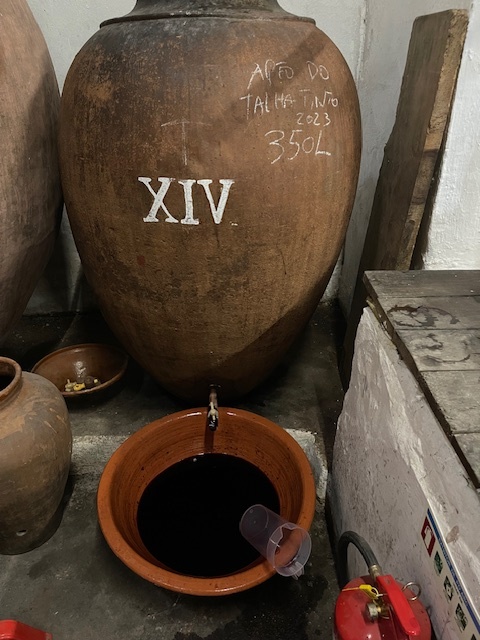
Freshly tapped talha at XXVI Talhas 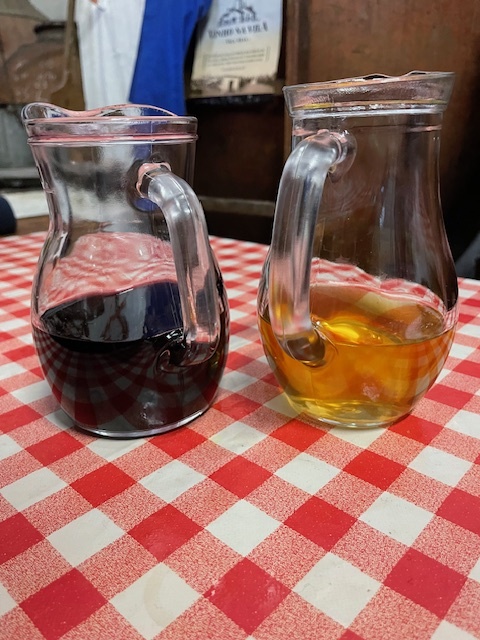
Pitchers of “new” red and white wines at XXVI Talhas 
Wines fresh from the talhas are served in tumblers 
An open talhas with a layer of olive oil on top
Using the classic talha winemaking method, foot-trodden grapes are dumped into a talha where they are spontaneously fermented on ambient yeast. The winemaker must be careful to break the cap daily to prevent pressure from building up and risking explosion of the vessel. After fermentation the talhas are sealed with olive oil until Dia de Sao Martinho when the “new” wine is deemed ready to drink straight from the talha!
The timeless allure of classic-style talha wines extends across the villages of Vila Alva, Vila de Frades, Cuba and Vidigueira, where they grace the tables of adegas, bars, and taverns. In these charming locales, the cherished tradition of sharing wines directly from the talha (until the talha is empty) with friends and family encapsulates the true essence of talha culture. Classic talhas wines fresh, delicious and “rustic” in the sense they are easy drinking. Think of them as the ultimate “house wine”!
Of course, there is more than one way to make wine in talhas. Growing interest in talha winemaking in Alentejo has prompted some modern and larger wineries make talha wines.
In 2010 Alentejo’s wine commission the “CVRA” created a Vinho de Talha DOC. Wine sold under this designation are sold in bottles and need to be quality controlled. As a result, new techniques and equipment have been introduced to facilitate the process without tainting the essence of talha winemaking (see photos below talhas in use at Fitapreta and Heredade do Esporão)
Bottled wines sold under the Vinho de Talha DOC are typically filtered and tend to be more complex as they are aged longer.
Drinking directly from the talha can offer a more authentic and rustic experience, while bottled talha wines provide a curated and often more widely distributed option. Both approaches contribute to the diverse and rich tapestry of winemaking practices in Alentejo, where talha wines hold a special place in its viticultural heritage.

Talha at Heredade do Esporão dates 1655! 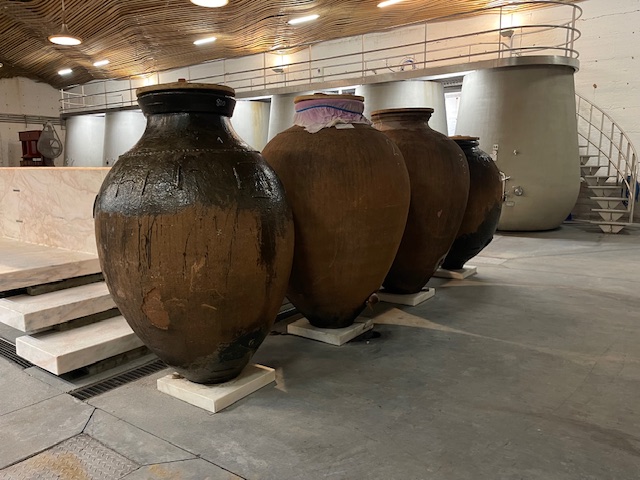
More Esporão active talhas 
An active talha at Fitapreta dated 1910
2. Indigenous Grape Varieties
With over 250 varieties, Portugal has the highest density of native grapes per square mile of any country in the world. Alentejo takes pride in nurturing and preserving its indigenous grape varieties. Red wine varieties like Aragonez, Trincadeira, and Alicante Bouschet, along with white wine varieties like Antão Vaz, Arinto, Roupeiro and Verdelho flourish in this sun-kissed land, contributing to the creation of wines with a true sense of place. These grape varieties have been cultivated for generations, forming a crucial part of the region’s viticultural heritage.
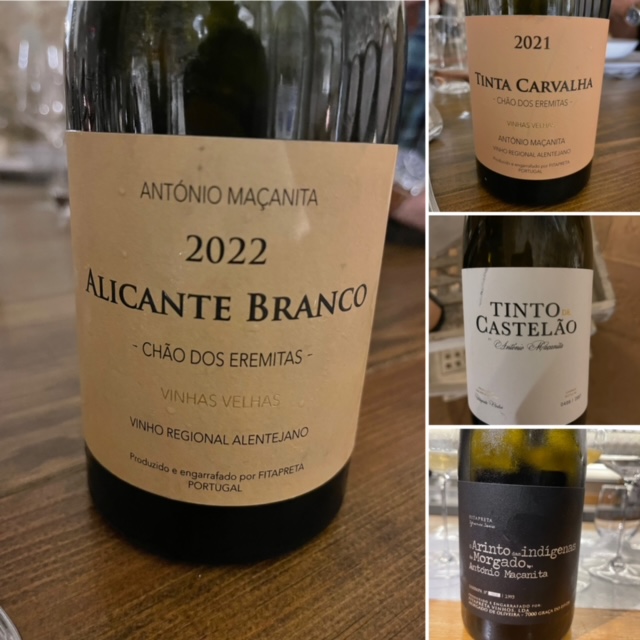
Alentejo’s winemakers are celebrated for their artful mastery in blending—an unsurprising feat considering the plethora of grape varieties at their disposal! But as the evolution of winemaking in Alentejo continues, you’ll find more mono-varietal wines being bottled. Such diversity!
3. Field Blends
Nestled in the sun-soaked landscapes of Alentejo field blend wines emerge as a captivating expression of the region’s winemaking prowess. Deeply rooted in tradition, a field blend is a wine produced from two or more different grape varieties (sometimes all red or all white, and sometimes both) inter-planted in the same vineyard, then crushed, macerated, and fermented together. In other words, the wine is blended in ‘the field,’ (vineyard) as opposed to being blended in the winery.
A plethora of grape varieties , both red and white coexists in some old vineyards, intertwining their flavors to produce wines that are as complex as they are distinctive.
We visited two wineries that produce field blend wines. Adega Mayor‘s “Tudo O Molho” is a”palhete” field blend wine. A palhete wine is a unique and traditional style crafted by blending red and white grape varieties during fermentation, creating a nuanced and refreshing rosé or chillable red style wine. Fitapreta also produces a field blend wine (see “Innovative Winemaking Techniques below).
4. Innovative Winemaking Techniques: While Alentejo cherishes its history, it also embraces modernity in winemaking. The region’s winemakers skillfully blend time-honored traditions with contemporary techniques, resulting in a dynamic and innovative wine scene. This fusion appeals to a broad spectrum of wine enthusiasts, from those who appreciate the classics to those eager to explore new and exciting flavors.
The Fitapreta A Laranja Mecânica is emblematic of modern Alentejo. Comprising a multi-vintage field blend of indigenous grape varieties Antão Vaz (arguably Alentejo’s signature white grape) Arinto, Roupeiro, Alicante Branco, Trincadeira-das-Pratas, Verdelho and Fernão Pires, sourced from sustainably farmed vines aged 25 to 50 years. Departing from conventional skin contact methods, this distinctive orange wine bears the unique Fitapreta imprint. They partially press the grapes, allowing 10-15% of the juice to rest inside the skins for a week. Crafted exclusively from the second pressing of these grapes. Fermented on native yeast, this wine defies convention, maintaining an inherent vinous elegance despite its rustic and unconventional technique.
Tasting note: It pours a pale, ever so slightly cloudy color orange with enticing mandarin orange, quince, candied mandarin orange zest, spiced peach aromas with a hint of pineapple. On the palate, it’s medium bodied and very fresh with a hint of tannins and alluring flavors that echo its aromas. This alluring wine reflects a true marriage of innovation and tradition.
5. Scenic Beauty
While navigating from one winery to another, it became more and more apparent to me that Alentejo offers a feast for the eyes. Rolling hills adorned with vineyards stretch as far as the eye can see, interrupted only by ancient cork oak and olive trees.
Paradoxically, while Alentejo reigns as the largest region in Portugal, it stands as the least densely populated. This unique feature adds to the region’s tranquil ambiance, making it an idyllic destination for those in search of a serene escape amidst the captivating beauty of the Portuguese countryside.





The picturesque landscapes create an ideal backdrop for wine tasting experiences. The inviting atmosphere of Alentejo’s wineries and tasting rooms ensures that visitors not only savor the wines but also the charm of the region.
6. Emerging Gastronomic Delights
Alentejo’s dedication to wheat cultivation, combined with its favorable climate and rich agricultural traditions, has earned it the designation of the “bread basket of Portugal.” In addition to wheat and other grains, there are cork trees (Portugal is responsible for around 50% of the world’s cork production) it seems wherever there are not vines or olive trees. And speaking of olive trees, Alentejo is home to at least indigenous olive varieties that have earned PDP status – Galega and Cobrançosa. Alongside savoring the wines of Alentejo, be sure to indulge in the pleasure of sampling the region’s delectable and uniquely flavored olive oils!
Its gastronomy is a flavorful journey that reflects the region’s rich agricultural heritage and cultural influences.

We were based in the charming capital of Alentejo – Evora which not only is a UNESCO World Heritage site but also a haven for food enthusiasts. The city’s diverse culinary landscape, features a mix of upscale dining in notable restaurant such as Alkimia Wine Lounge, 5Amendoas, and casual gems liken Dona Laura which contribute to the gastronomic allure of the Alentejo region.
We also dined at a few wineries Adega Mayor, Enoteca Cartuxa, and Quinta do Quetzal with excellent onsite restaurants and outstanding wines to match.
It’s customary to be served Pão Alentejano, a traditional distinctive bread, made from local wheat and baked in wood-fired ovens. A beloved staple in Portugal, this bread’s distinction lies in its exquisite textures: a crispy exterior embracing a luxuriously dense crumb. Elevate the experience with a touch of salted butter or, my personal preference, the rich essence of local olive oil.
7. Sustainability Leadership
Alentejo the only wine region in Portugal with a sustainability program. The Wines of Alentejo Sustainability Program (“WASP”) was launched in two phases. The first in 2015, the second in 2019.
WASP 2.0 launch this month, and raises the level of sustainability and sets the Alentejo region as an example in the implementation of sustainable agriculture measures. The program’s sustainable production certification adds to its acclaim, gaining recognition on an international scale.

WASP is a voluntary membership program whose objectives are to reduce costs and increase economic viability through a proactive approach to environmental pressures and social concerns.

Each of the items in the chart above represent a “chapter” and each chapter has criteria (there are total of 171) for self-evaluation and accountability. Achieved criterion lead to third party certification which is required for members to tout their sustainability.
The WASP already has 639 members covering around 60% of the Alentejo wine region, corresponding to more than 13 thousand hectares, and currently 20 producers bear the sustainable production seal.
WASP’s impact has been acknowledged by the 10 awards it has received, including:
- Rural Ambassadors from Project Liaison (funded by the European Commission)
- Green Awards 2020 Amorim Sustainability Award for an Association from The Drinks Business
- The Deloitte Portugal Sustainability Initiative Award (investor relations and governance)
8. Value.
One memorable evening we attended a dinner sponsored by CARMIM, Alentejo’s largest winery. Our culinary journey commenced with a stunning traditional method sparkling wine, aged for an impressive 36 months with secondary fermentation in the bottle. To our surprise, when we asked about the price, CEO João Caldeira casually mentioned it was a mere €8. The incredulous expressions around the table mirrored our collective disbelief at the remarkable quality-price ratio. This experience was just one among many instances where Alentejo wines consistently left us astonished by the exceptional value they offered.
9. Wine Tourism
Alentejo has garnered numerous accolades in the realm of wine tourism:
Elevate your wine tourism experience by staying at one of Alentejo’s luxurious wine estates. Many properties offer accommodations surrounded by vineyards, providing an immersive and tranquil escape. Guests can enjoy exclusive wine tastings, spa treatments, gourmet dining experiences, hot air ballooning and more!

The beautiful grounds at Adega Mayor 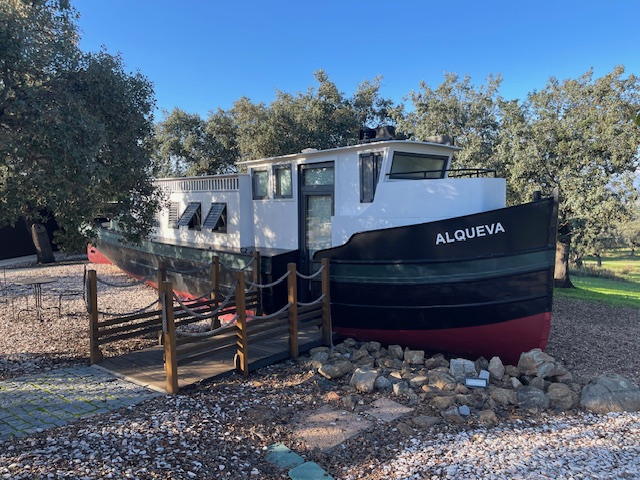
One of the unique on-site accomodations offered by Adeda Mayor
10. Hospitality
Finally, I must tell you I was very impressed by genuine warmth of the region’s winemakers, hospitality staff and locals and locals throughout my experience in Alentejo. Hospitality seems to be deeply ingrained in Portuguese culture, and the spirit of community we found in Alentejo was remarkable.
The Alentejo wine region stands as a testament to the harmonious marriage of tradition and innovation, history and modernity. A visit to this enchanting corner of the wine world is not just a tasting experience; it’s a journey into the heart and soul of Portuguese winemaking. Alentejo beckons, inviting wine lovers to savor its diverse array of wines and flavors, and to immerse themselves in the magic of this truly special wine region.
Thirsty for more? I invite you to explore my additional articles on Alentejo for a deeper dive into this enchanting wine region:
- Rediscovering Alentejo; A Journey Back
- Alentejo On My Mind; Part 1-Sustainability
- Alentejo On My Mind; Part 2 – Exploring The Wines of Alentejo
- Wine of the Week: 2018 Quinta da Fonte Souto, Branco, DOC Alentejo, Portalegre
- Two Moreish Monte Velho Wines From Esporão
________________________________________________________________________
Follow me on Twitter, Facebook, Instagram, for all things wine. As a wino with latent foodie tendencies, you’ll also find food and wine pairings, and food related stuff! Become a fan and join ENOFYLZ Wine Blog on Facebook. Cheers!
Copyright Notice: This entire site is Copyrighted 2010-2023. All Rights Reserved. No unauthorized copying of any section of this site is permitted. If you wish to use any part of this site, contact me. For information on Copyright Law, see the official U.S. Copyright Office home page.



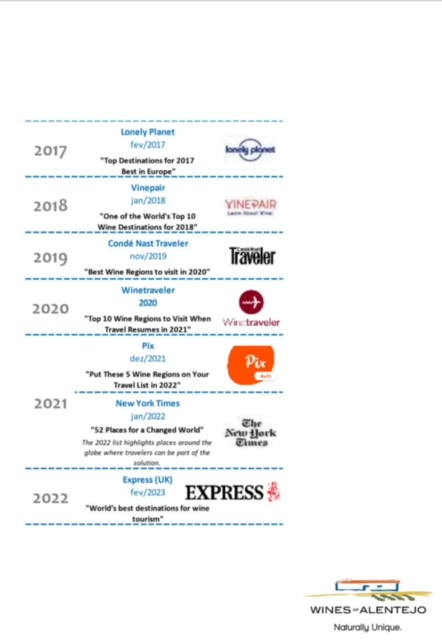
Thanks for the comprehensive tour Martin. Looks like fall is a beautiful time to visit.
You’ve been such a great ambassador for this region, we’re so glad you were rewarded with such a wonderful experience! Bookmarked for a future AdVINEture some day!
Very nice article Martin! You took time to share the minute details experienced on this fantastic trip, and also Alentejo info packed. You’ve been a proponent of the area and wines… I continually look for them here. I’ll refer to this post when planning my trip!
Lots of depth in this article and hence useful.